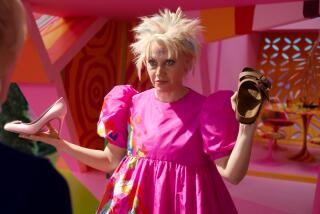Irvine Chain Builds a Better Mannequin
- Share via
Consider the poor mannequin’s lot. First she is called a dummy. Second, no one notices her, just her clothes. Then she is tossed out the moment she is out of style.
But as tough as her job is now, the mannequin has come a long way from her wax-figure ancestors. Before vinyl plastic was perfected in the 1950s, mannequins were made of wax by European factories. After a few hours in the shop windows, they would start to droop under the heat of the lights. Plaster was used next, but it was too fragile, and the mannequins often ended up in pieces on the shop floor.
Today’s mannequins are well maintained and expensive. Ranging in price from $200 to $800 each, many have pivotal joints, high-quality synthetic hair and eyelashes, and even muscle tone. Some even have discreet imperfections to bolster their credibility. But do people really notice them?
“They may not notice the details, but they see the overall effect,” said Norm Glaser, president of Patina Visuals, a mannequin manufacturing firm in the City of Industry. “The only proven method of selling fashion is three-dimensional. Mannequins are the best way to show clothes because we can all relate to them.”
Although shoppers may not notice all the nuances, mannequins gently bow to the fashions of the day. When they can’t keep up, out they go. In the 1950s, female mannequins had larger breasts, wider hips and demure expressions. Now, the demure look is out, along with large breasts and hips.
“The mannequin’s life is three years,” Glaser said. “Fashions change. There was a time when we had a rigid bust line because of the bra styles of the day. Then people stopped wearing bras, so if a mannequin had a stiff bust it would look out of style.”
Another trend mirrored faithfully by the mannequin industry is physical fitness. Before the 1980s, mannequins did not have muscles. Now they have good muscle tone and joints to facilitate “action poses.”
Like a lot of things that have grown more futuristic over the years, mannequins have adopted a high-tech look during the last decade. In fact, some are so modernistic they barely resemble human forms at all. Among the pioneers of the high-tech mannequins is a growing chain of 46 clothing stores based in Irvine called Wet Seal.
Begun 30 years ago as a swimsuit boutique on Balboa Island, Wet Seal was bought by two Canadians in 1984. During the last 36 months, new owners Ken Chilvers and Suzy Shier have added 29 stores. They plan to open another 17 by the end of 1988.
Wet Seal mannequins have no heads and no feet. Hung from the ceiling or perched on a rack, the dummies are draped in junior fashions and posed in varied ways to give the impression of movement, adventure. Seen in the sleek Wet Seal shops, they convey a feeling of excitement.
“We are a very junior, forward company, so we figured anything nontraditional and fun is the right look,” said Chilvers, the company’s president. He added that when the company was bought four years ago, the store interiors were all redesigned with modern mesh accents; mesh mannequins were selected because they are visually compatible.
Chilvers offered another reason. Futuristic mannequins don’t age. With no heads or limbs, the forms don’t have hairdos that will go out of style or need tending. And with no flesh-colored plastic, there is little to keep clean.
The Wet Seal mannequins are made of tubular steel by a company called Counter Balance in Pacoima in Los Angeles County. Counter Balance makes two mannequins: Manworks, which have pivotal joints and cost $275 each, and Newforms, which do not have pivotal joints and cost $200. The company makes about 3,000 mannequins a year and sells to Jay Jacobs, J.C. Penney, JW Robinson’s and other major department stores, as well as such specialty chains as Wet Seal.
Abstract mannequins can cut overhead costs substantially. A realistic mannequin’s life may be three years, but abstract forms can last indefinitely.
“With the traditional mannequins you have to be very conscious of keeping them in style,” Chilvers said. “That becomes a major problem. Our mannequins don’t go out of style, and they won’t wear out in the near future.”
Like clothes that go out of fashion, old mannequins are given or sold to “basement” or discount stores or thrown out.
Glaser, whose company manufactures both realistic and abstract forms, agreed that realistic mannequins must reflect the latest styles. He said mannequins used to be perfectly beautiful, but in the last two decades preferences have leaned toward slightly imperfect models.
“We used to make mannequins’ faces so perfectly beautiful that it scared people,” he said. “We now make them with slight imperfections, so that put together with the clothes they are still beautiful, but the customer can relate to them better.
“It’s like Lauren Hutton’s teeth. She had this wonderfully imperfect smile, and she was a top model.”
Real models have been used for mannequin molds for years, Glaser said. His company works with modeling agencies, which send models to pose for the molds. Once the mannequin forms are finished, artists apply the finishing touches of makeup, nails and facial characteristics. The most successful models of the day influence almost all the mannequins in some way, Glaser said.
“Twiggy may have had a terrible body, but she launched a lot of mannequins.”
More to Read
Sign up for The Wild
We’ll help you find the best places to hike, bike and run, as well as the perfect silent spots for meditation and yoga.
You may occasionally receive promotional content from the Los Angeles Times.






